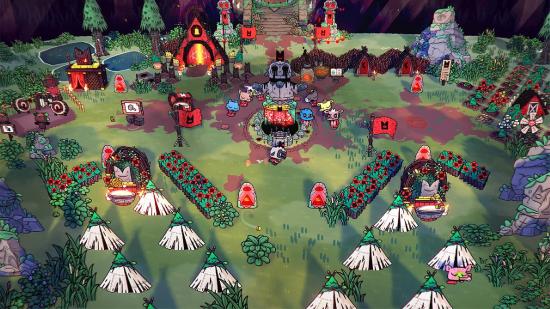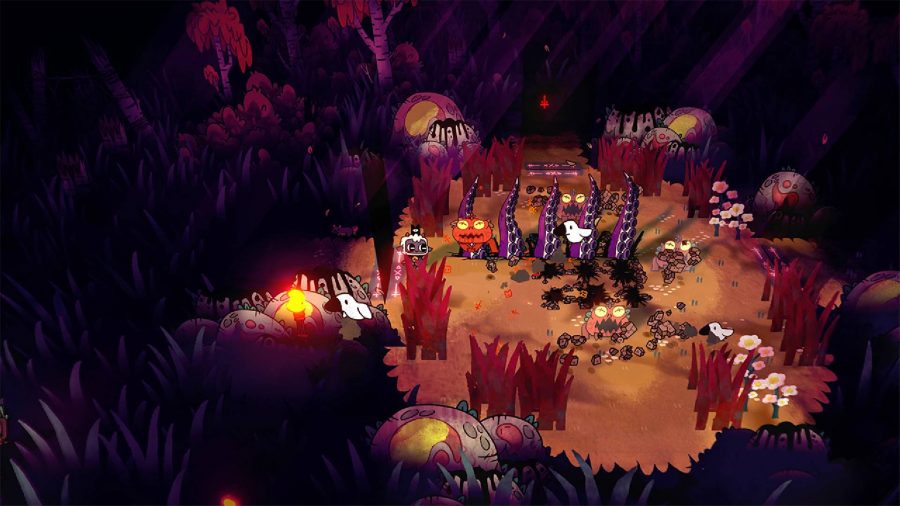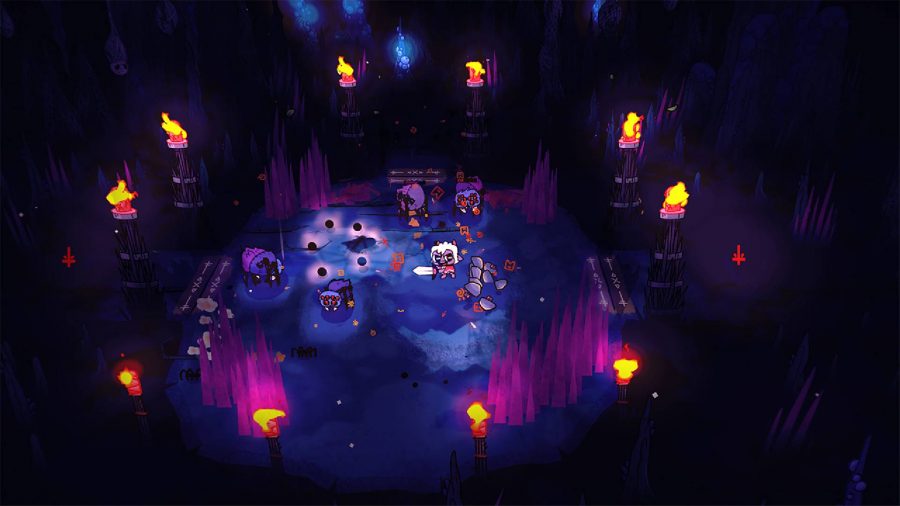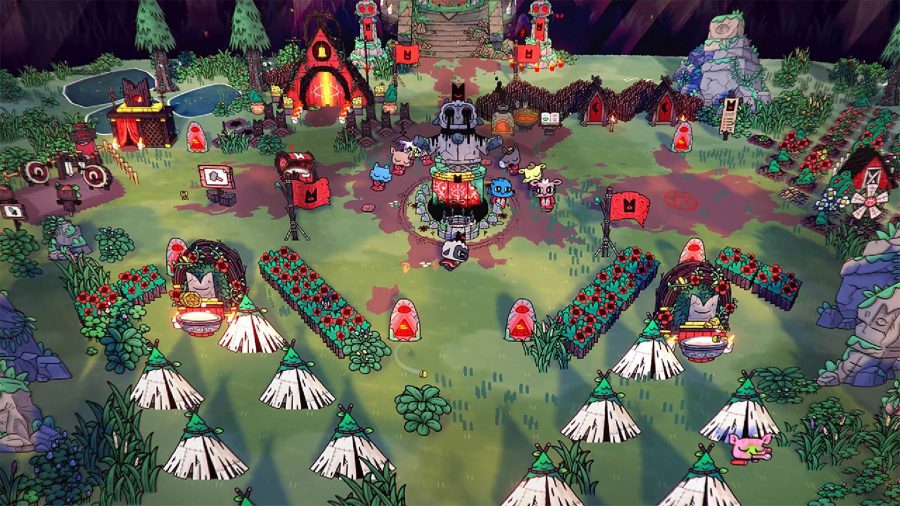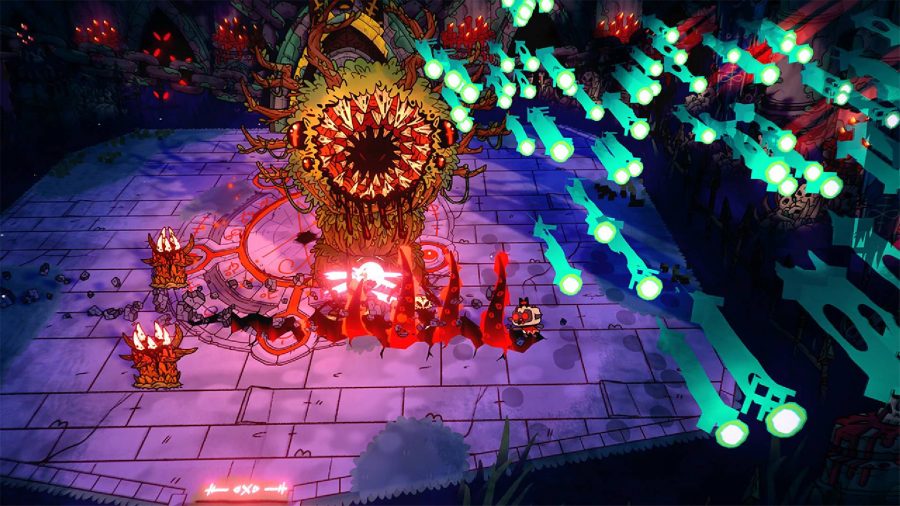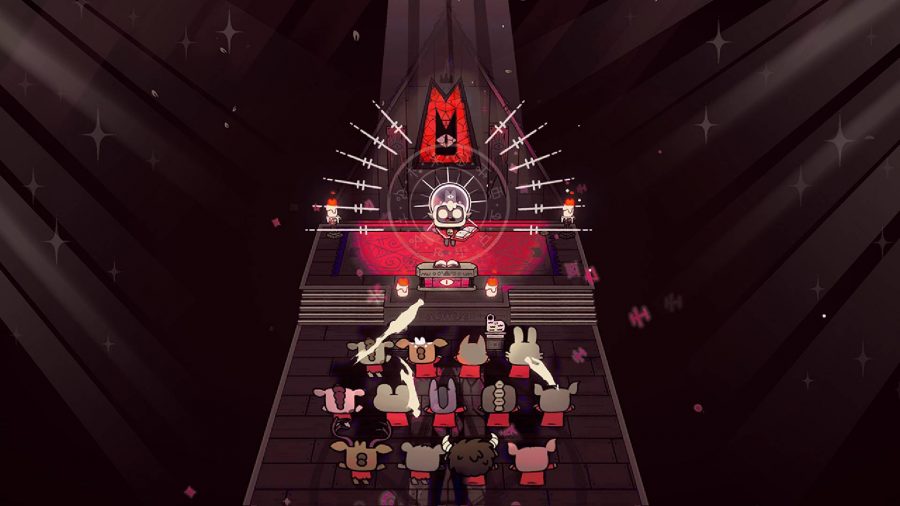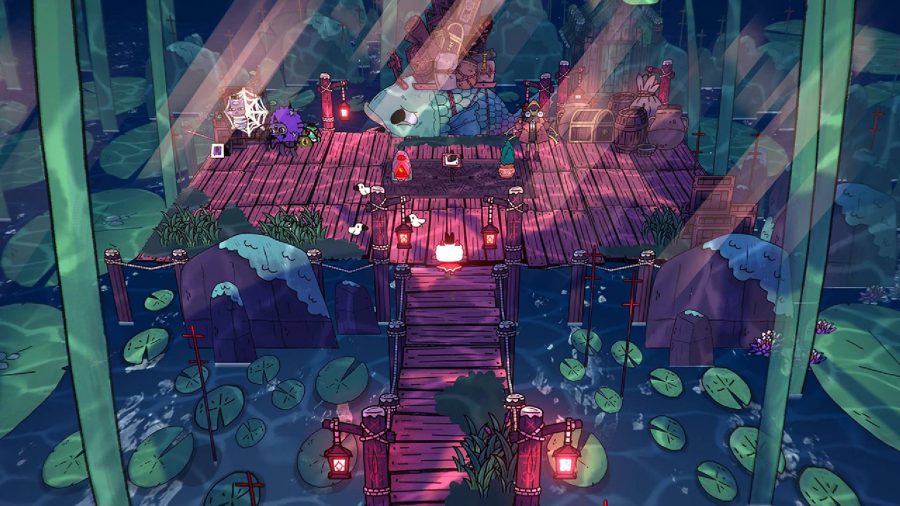Our Verdict
An incredibly detailed and accomplished game that deftly balances combat with managing your very own occult village, Cult of the Lamb is an amazing game that deserves to be played. But no amount of humour or depth of mechanics can save the consistent and disappointing performance. I pray to Cthulu that some patches can bring this essential title up to snuff on the Switch.
As I get older and realise more about my preferences, perhaps it’s the soothing nature of things, but I absolutely adore micro-management in my video games. I’m also an avid fan of the supernatural and the occult and love a good rogue-like, so Cult of the Lamb beeped loudly on my radar since I first saw a trailer.
A rogue-like action game with a cult managing twist, Cult of the Lamb has you playing as the titular lamb who was sacrificed to appease four Eldritch gods, only to be spared by “The One Who Waits”, an imprisoned god who promises you eternal life in return for slaying the four gods who shackled him in chains. You need to gain followers, manage a cult, and slowly build up your strength to challenge the daunting enemies ahead.
With the best split gameplay systems this side of Moonlighter and an art style reminiscent of the gory Happy Tree Friends, Cult of the Lamb has a lot going for it, and mechanically it delivers in spades. But sadly, things seem a little undercooked with the Switch port, and technical issues mean my bite of this lamb left me with a sour taste.
In Cult of the Lamb, there are four dungeons, each containing one of the gods, and when you return from these dungeons you have a town full of followers to manage. These followers offer you devotion and divine inspiration that can be used to improve your skills, unlock new abilities, and much more.
All these systems work beautifully in tandem with each other. When exploring the dungeons you’re given the option of which path to choose, with the possible rewards detailed in icons including more followers to find and indoctrinate in your cause, usable items like lumber or rocks, or the chance to meet unique characters and unlock different corners of the map.
The combat itself is also very simple, with just a main attack button, a dodge roll, and a magical attack which demands fervour, a resource dropped by enemies upon their death. Each run presents you with a weapon and a magical ability at random, with the opportunity to find more as you explore further into the depths of each dungeon.
Weapons themselves start out simple, with a mixture of quick weapons with low attack, or hulking great axes that need some time to swing but deliver a devastating blow to your foes. Over time these add different elements like vampirism (allowing you to regain some health from your slain enemies), weapons that recharge your fervour, swords that summon a spirit from your foes to attack others, and so much beyond. It all builds up slowly but at a satisfying pace that keeps the combat fresh while never over-complicating things.
Your magical abilities also have a nice mixture of AoE attacks, projectiles, and debuffs like poison. The enemies you face are themed in each dungeon but start to really test you later on, so the mixture of possible combat options is appreciated, though the random nature can mean it’s a little tough to find the right weapon for the current dungeon, meaning sometimes you start with a better loadout than others, but that’s part of the rogue-like appeal.
Crucially, you also don’t get to fight the main gods the first time you reach the end of a dungeon, instead, you must complete each area three times first, before tackling the much tougher antagonists on your fourth run. There’s a lot to do anyway in Cult of the Lamb, but this extra time is nice and adds a lot to the game, while still keeping things different enough each time to avoid feeling like padding. Plus, the number of resources, abilities, or followers you can unlock means each run is worthwhile, with death only punishing you by taking a percentage of your loot, instead of completely wasting your time.
There are even run-specific boons in the form of tarot cards, which can be found from a vendor on each new adventure. These add extra abilities to combat, such as providing extra damage at the cost of your health and plenty more interesting wrinkles. You unlock these by buying them from different characters in both the dungeons and the overworld, with over thirty possible cards to find and plenty of interesting combinations possible that can really affect your run.
Now the other half of the coin, and possibly my favourite, is the cult management. Every resource is crucial and every extra follower absolutely essential to you meeting your goals. In fact, you can only unlock later dungeons when you have a specific amount of followers, so this is not a part of the game you can ignore. A wide open area is yours to decorate and populate, starting with a summoning circle and a statue for your followers to worship, giving you the resource known as divine inspiration once you have collected enough devotion, which is how you unlock new buildings in your commune.
To begin with, you have to clear trees, mine rocks, cook every meal to avoid your followers starving, and even pick up your cult members’ poo and sick when they are ill. You even need to build beds and provide for them, lest their loyalty to you falter and allow non-believers into the cult, which will spread dissent and lose you that precious devotion you need to proceed. It’s a novel set-up for a fairly simple town-management system, but it works, and it does everything really well in the process.
That slow introduction of useful buildings is so satisfying, such as the outhouse for followers to poop in, which then allows you to collect fertilizer for your seeds. There’s a silo to hold seeds, a farmhouse to encourage your followers to tend to crops, and a scarecrow that can keep pesky birds from stealing your precious harvest. I’ve unlocked a huge variety of useful buildings that all slowly automate those smaller tasks, but also unlock new abilities like the missionary, which allows you to send followers out on a holy quest, where they could return with valuable resources, providing they survive.
So there are already a lot of systems at play, but I feel like we’ve barely scratched the surface. Your lamb can hold a sermon every day, gathering faith from your followers that allows you to purchase new doctrines, that then change how you operate your cult and how your followers react to the many systems in play. I have a doctrine called ‘belief in sacrifice’ that gives all my followers extra loyalty when one of them is sacrificed. I’ve gained the ability to increase faith just by placing more decorative items in the cult area, and I’ve even unlocked the ability to marry a follower for a hefty extra dose of faith. It’s another wrinkle, but once unlocked new doctrines are presented to you in an option between two, letting you decide exactly how benevolent or harsh you want to act as a ruler.
The followers themselves are also a great emblem of the game’s dark humour, with funny dialogue throughout and the occasional quest that made me laugh uncontrollably. At one point, one of my followers dared me to make another eat poo, and they were so happy with the result that afterwards, they asked me to do it again because it would be even funnier. While NPCs and the godly antagonists deliver well-written dialogue that flirts around the occult, the followers are a constant source of joy and witty humour.
Next, there are even more unlockable abilities, as the crowns of the four gods let you choose between four essential new perks like the ability to return from death once at the cost of a follower. In fact, the higher the loyalty of the followers the more health you have on returning, making it a gut-wrenching sacrifice when you must choose which beloved animal to gut for their essential life force, just for you to tackle those difficult later enemies. You can even unlock new fleeces for your lamb with more abilities and so much more.
Finally (I promise we’re nearly there), the action isn’t just split between the cult and the dungeons, as an overworld fleshes out this universe and is unlocked over time as you meet the necessary NPCs on your quests. New areas unlock fishing holes to gather those scaly suckers so you can make better meals and a forest full of mushroom people offers even more abilities if you can gather some fungi for them.
Each area also holds blueprints for new decorations and buildings, specific tarot cards to be bought with cash, and further unique elements that somehow add even more complexity to this game. I particularly love the fishing mini-game, which has the unruly difficulty of the early hours of Stardew Valley, as well as the dice game knucklebones which I admittedly got a little addicted to playing. I feel like I’m still leaving stones unturned, but just know that each mechanic is explained clearly and only adds extra detail to your playthrough.
Crucially, I never feel overwhelmed. There were times when my followers demanded things while I was still in a dungeon and I had a lot to deal with when I got back, but it never felt like it was pulling me away from the action. Occasionally I’d come back to a dead body that had to be buried, lest followers get sick, or buildings that collapsed and needed to be rebuilt. But, your followers will act on your command, so if you tell them to build, they will, if you tell them to mine resources, they’ll plough away during the day while you’re working. There’s a lot to manage, but the game always feels like it’s giving you what you need to manage everything, however slowly these options get unlocked.
Honestly, I’d love to stop my review here. Cult of the Lamb is a deep, satisfying title that manages to balance its combat and management elements beautifully, and somehow makes both sides of the game feel deeper and more interesting than whole games that only did one of those things. It also looks absolutely gorgeous, with the thick outlines and bold colours especially popping on the OLED screen. The character designs are cute but consistently great, and you can even customise your followers to look like deer, fish, crabs, eldritch monstrosities, and even Cthulu himself if you grab the free DLC currently available.
Sadly, one thing holds me back throughout every minute of my gameplay, over the fifteen or so hours I’ve played to beat those four dungeons. The performance on Switch is atrocious. The framerate is wildly inconsistent, causing more dropped frames than a bull in a window shop. Even quiet gameplay moments are affected by this constant juddering, but the second the action picks up with a few enemies or projectiles on screen, we’re talking pauses that occasionally feel like a whole stagnant second of a single image, while the game struggles to process what comes next. This makes combat occasionally absolutely brutal, with split-second decisions needed to avoid death, and the game’s performance constantly making that a chore.
Even minigames like fishing and cooking cause abysmal slowdown, meaning I frequently burnt meals even when the action to do so successfully gives you a wide-open slider that should be easy to avoid failing. As the game turns from night to day, it feels like the game stops for several seconds, and there are so many other areas where it’s frankly unacceptable to see so many issues.
During one boss fight when I reached the end of my health, I just stopped receiving damage somehow. I was not sure at first, but my hearts were completely empty and I hadn’t died, so I stood in the middle of the level and just let myself get pummeled, only to confirm that I had just stopped taking damage. When I eventually won the fight (very unfairly) the game stuck on the next frame for several seconds, as if trying to figure out exactly why I was still there, before luckily sending me back to the town with my progress unscathed.
I was also soft-locked out of the game multiple times, where I performed an action like holding a sermon or a ritual, only for the game to get stuck in a loop where my only option was to turn the entire thing off and lose progress. For some reason on the starting screen, my timer has wildly miscalculated the time I’ve been playing the game, still saying only 43 minutes when I’d already put enough time for about 30 days of in-game time. There’s even the odd spelling mistake in the text, giving the feeling that this game and especially the Switch version needs a few more weeks in QA, and definitely extra time for optimisation.
Did this ruin my gameplay experience? Not quite, as there’s so much to love here and when it works, the mechanics all come together wonderfully. I would just recommend right now either picking it up on another platform or waiting until developer Massive Monster and publisher Devolver promise and deliver some essential maintenance. This should be the perfect pick-up-and-play Switch game, letting you enjoy the thrilling action on the TV, and then relax with some downtime in your cult in handheld, but I just can’t recommend it right now.
Altogether, Cult of the Lamb is possibly my favourite indie of the year so far, and it somehow wildly over-delivered on my expectations with its dark humour, labyrinthian depths of gameplay mechanics, and a beautiful dichotomy between the two gameplay elements that all feed into the other perfectly. But framerate issues and the general performance had me unjustly dying far too often and shouting at the screen while making even the more mundane moments an unnecessary slog. If Cult of the Lamb receives some gameplay improvements I’ll happily slap a nine or possibly even higher on this one, but I’m genuinely so disappointed at the current state of this port.
